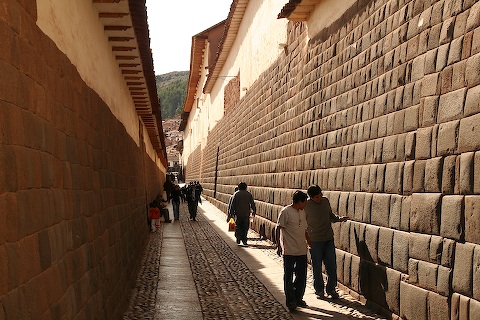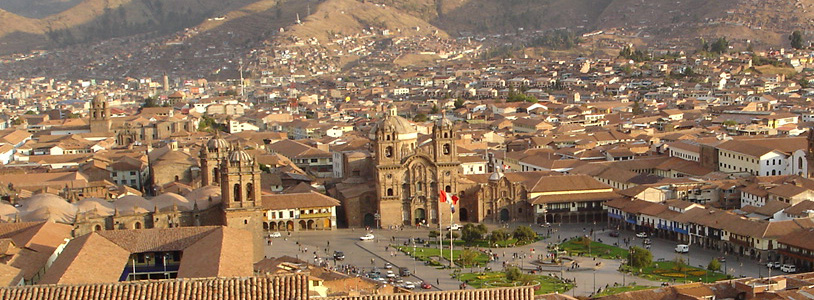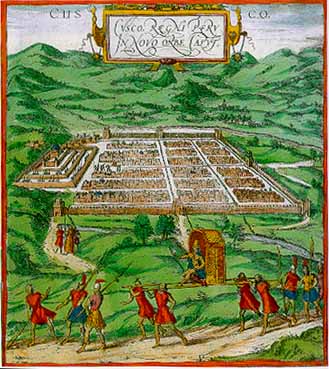Kim MacQuarrie’s Peru & South America Blog

Cusco (3-4 Days)
Visiting the Location where Diego de Almagro Captured Hernando and Gonazalo Pizarro During Almagro’s Seizure of Cusco in 1537
(Above: Loreto Street in Cusco; on the left is the wall of the Inca palace known as the Amaru Cancha.On the right is the outside wall of the Acclawasi, or the temple of the “Chosen Women”).
It was in 1537, shortly after Manco Inca lifted his siege of Cusco, on the southeastern portion of Cusco’s Plaza de Armas, where Hernando Pizarro, his brother Gonzalo, and about twenty followers were seized by Diego de Almagro—the first in a chain of incidents that would lead to a deadly civil war. The Pizarros had holed up in Huayna Capac’s former palace of Amaru Cancha in 1537, just as Diego de Almagro, Pizarro’s former partner, had returned from Chile. Much of the site is now occupied by the Jesuit church, La Compañía; however, some of the wall of the Amaru Cancha can still be seen on the eastern side of Loreto Street, that runs from the southeastern part of the square (Amaru Cancha, in the Incas’ language, Quechua, means “Snake House” or “House of the Serpents”; the snake among the Incas was a symbol of knowledge and learning, a stone with a carved snake can still be seen along Calle Loreto, on one of the Amaru Cancha’s walls)…
(more…)

Cusco (3-4 Days)
Visiting Cusco’s Plaza de Armas, or Main Square
On November 15, 1533, Francisco Pizarro and his men arrived in the city of Cusco, after skirmishing with an Inca army to the north of the city, but which during the night had withdrawn. Pizarro and his men thus walked unopposed into the city, and bivouacked on the main square. The square, twice the size of the present one now, was lined with the palaces of former Inca Emperors and these were quickly seized by Pizarro and his top captains as residences.
The original Inca square was divided in the middle by the Saphi River, which now runs beneath the buildings on the southwest side of the square (the portals of which are called Portal de Comercio and Portal de Confituría). The rest of the Inca square was partially comprised by what is now known as the Plaza Recogio, which lies a block to the west.
Locations of the Conquistadors’ and Inca Emperors’ Palaces
On the northwestern corner of the Plaza de Armas once stood the Casana, presumably one of the palaces of the last Inca emperor to rule over an undivided empire: Huayna Capac, the father of the two warring brothers, Atahualpa and Huascar, and also of Manco Inca and Paullu Inca. Francisco Pizarro quickly selected this palace to reside in and a corner of the palace still remains, part of what is currently the Pachacutec Bar & Grill…
(more…)

Cusco (3-4 days)
The Arrival of the first Spaniards in Cusco
In 1533, while Francisco Pizarro and his men held the Inca Emperor Atahualpa hostage for a ransom of gold in the north of Peru in Cajamarca, Pizarro sent three of his men—a Basque notary and two former sailors—600 miles southwards to Cusco, a city the Spaniards had only heard about but which they had been assured held vast quantities of gold. Pizarrro’s instructions to his men were to “take possession” of the city for the Spanish crown, and to help expedite the collection of gold and silver for Atahualpa’s ransom. The two sailors and the notary were thus the first Europeans to be carried in royal Inca litters along the spine of the Andes and were also the first Europeans as well to view and enter the Incas’ capital.
Quoting from chapter 5 of The Last Days of the Incas, this is some of what they saw:
“The small procession soon headed south from Cajamarca, climbing the flanks of fantastic mountains, cutting past pale, blue-green glaciers, crossing through Inca cities and villages set besides rivers that sparkled in the sun, then traversing giant gorges on hanging Inca bridges while witnessing vast flocks of llamas and alpacas that seemed to extend for as far as the eye could see. Strangers in a strange land, these were the first Europeans to witness an untouched Andean world never before seen, one with a thriving native civilization in all of its color and scarcely understood complexity. Everything was new—plants, animals, people, villages, mountains, herds, languages, and cities. A trio of Marco Polos adrift in the New World, they were similarly off to seek riches in a distant and fabled city….
(more…)



